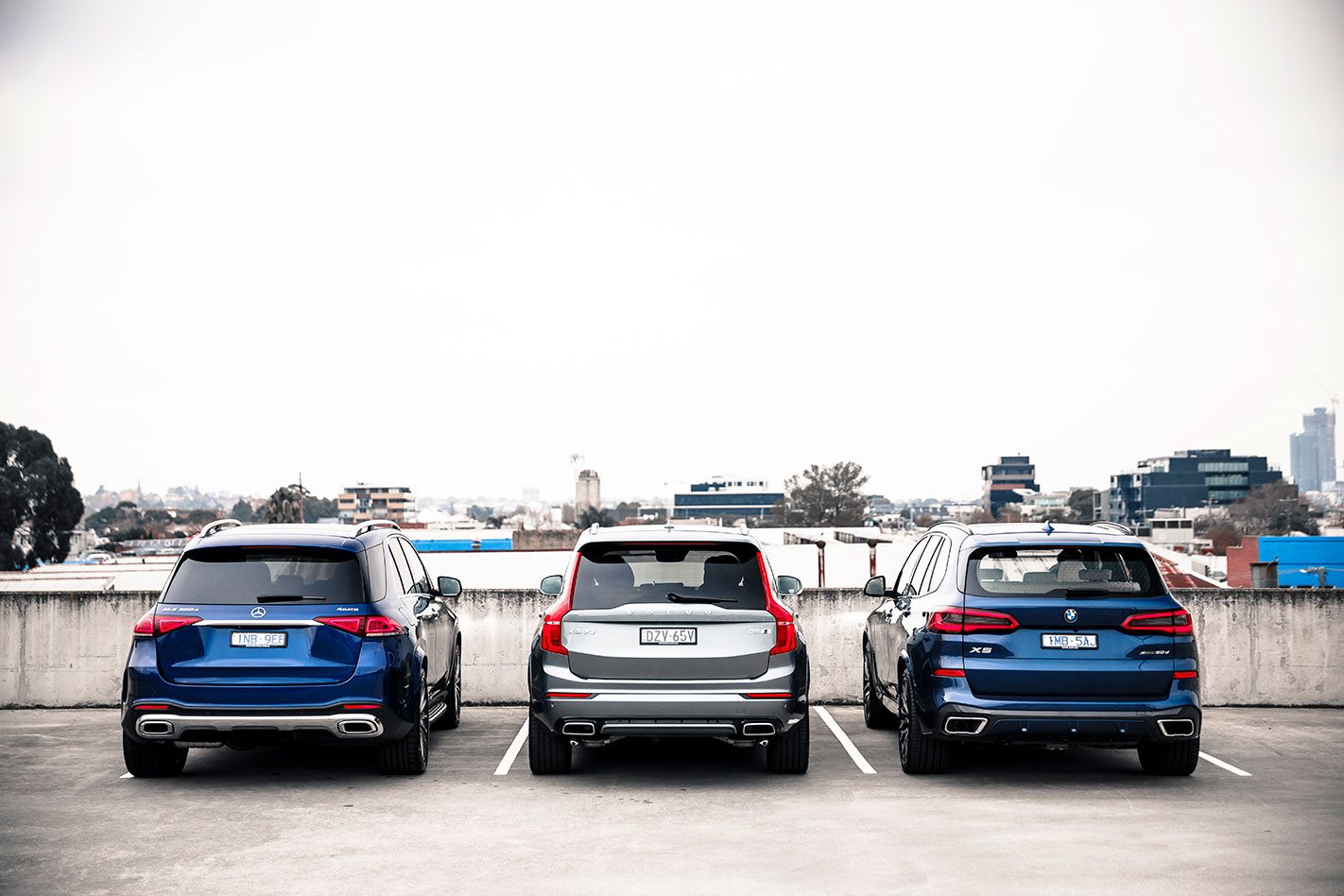IT’S A cold, misty morning on Melbourne’s Chapel Street. Traditionally a location heralded as a hot-spot of fashionable excess, the famed strip’s gentrification has fostered an environment where expensive boutiques now mingle with commonplace stores filled with pragmatism. In a weird irony, the three luxury SUVs we’ve assembled reflect the street in which they’re parked. All are family-friendly, diesel-powered rivals that provide vast convenience and versatility. However, they also attract a circa $100K price tag, meaning the Mercedes GLE, Volvo XC90 and BMW X5 remain desirable, premium purchases. The well-heeled certainly are spoilt for choice.
Given the increasing prevalence of the luxury SUV segment, a marque like Mercedes-Benz can’t afford to flounder – yet its GLE has been barely treading water. For the first half of 2019 BMW managed to shift 1792 X5s, while Benz found driveways for just 349 GLEs. Rubbing salt into the wound is the fact that the Volvo XC90, which was released in 2015, found 632 buyers up until the end of June.

That’s why the new GLE is so important to the Three-Pointed Star. It’s the latest kid-carrier on the overtly trendy SUV block. To prove Mercedes means business, it has been armed with keen pricing. The box-fresh 300d enters this battle with the lowest base figure of the trio at $99,900, giving it a slight advantage over the $101,900 XC90 D5 R-Design and a massive head start on the $112,990 X5 30d.
However, early on a, ahem, bump in the road becomes glaringly obvious. The Mercedes is so new that, at the time of testing, it’s yet to be released locally. With few on the ground, we’re given an example of the 300d sans air suspension – it’s riding on steel springs and passive dampers, and running optional 21-inch AMG alloys (as part of the $9900 AMG Sport Package). Against competition sporting optional air suspension (Volvo) and adaptive dampers (BMW), it seems the Benz is entering this fight with one hand tied behind its back.
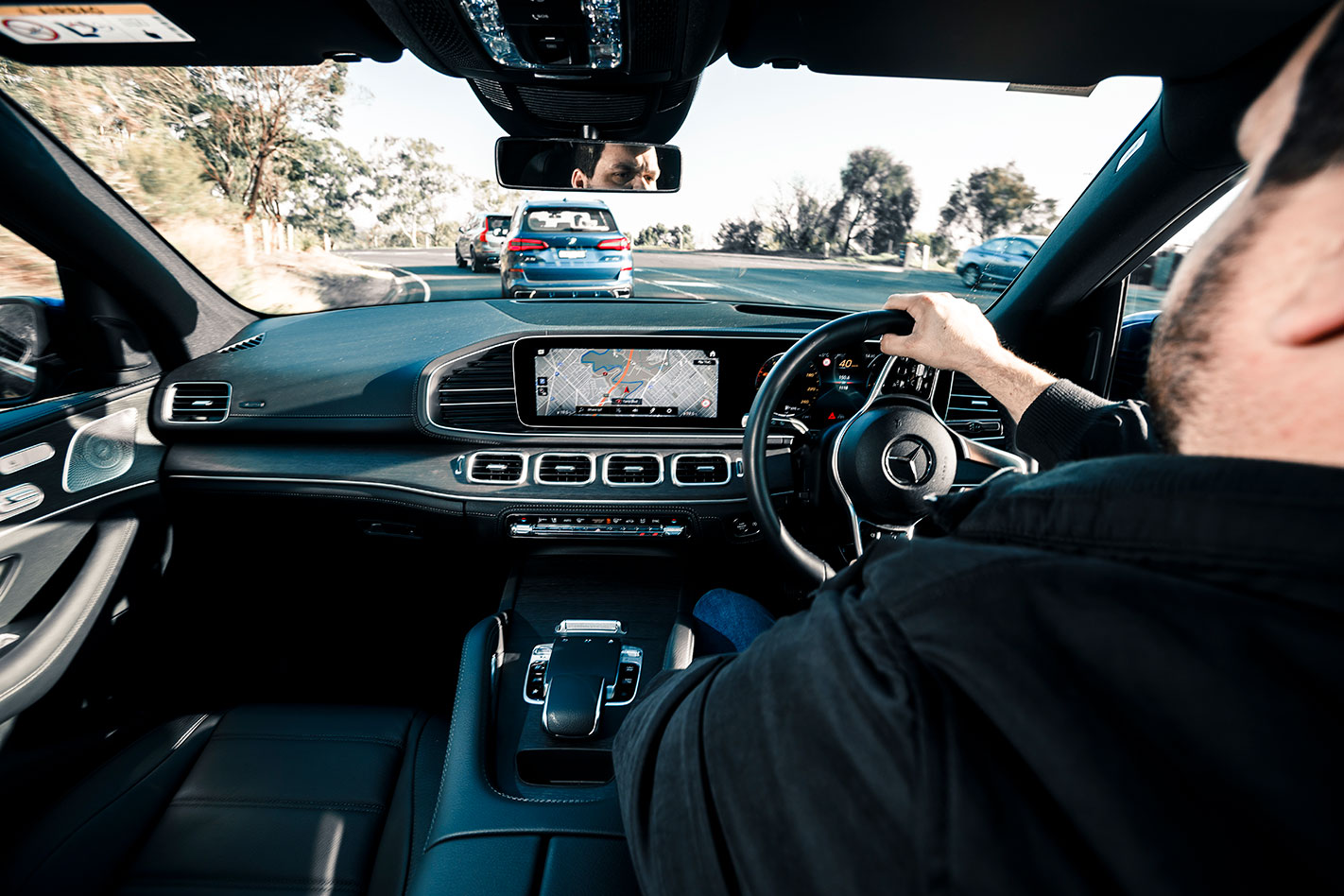
For a fairer comparison, you can option air on the GLE for $3800, or as part of the $4800 Night Package, which also adds black highlights and 22-inch wheels, and on past experience, Mercedes expects around half of owners to do so. Plus, if ride comfort is a top priority (and you have pockets deep enough) you can even spruik for Merc’s E-Active Body Control for $13K, though this is only available on six- and eight-cylinder GLEs, which taints the value proposition somewhat.
Talking of balooning sticker prices… the BMW X5 xDrive 30d is easily the most expensive of this trio. An entry-level, four-cylinder turbo-diesel 25d is on its way, but for now BMW offers the mechanically talented in-line six as its base model. The G05 X5 has grown in size, but hampering the 30d’s value equation is the fact that the price as optioned here is $131,090. Ouch.
That extra $18,100 is accounted for by an instrument panel finished in leather ($2700), metallic paint ($2000), M Sport Package ($4000), 22-inch M light alloys ($3900), four-zone climate control ($900), BMW Laserlight ($2400), Harman/Kardon audio ($1300) and wireless phone charging ($900). Strangely, for an SUV so highly specified, heated seats are a glaring omission, one duly noted in the frigid weather.
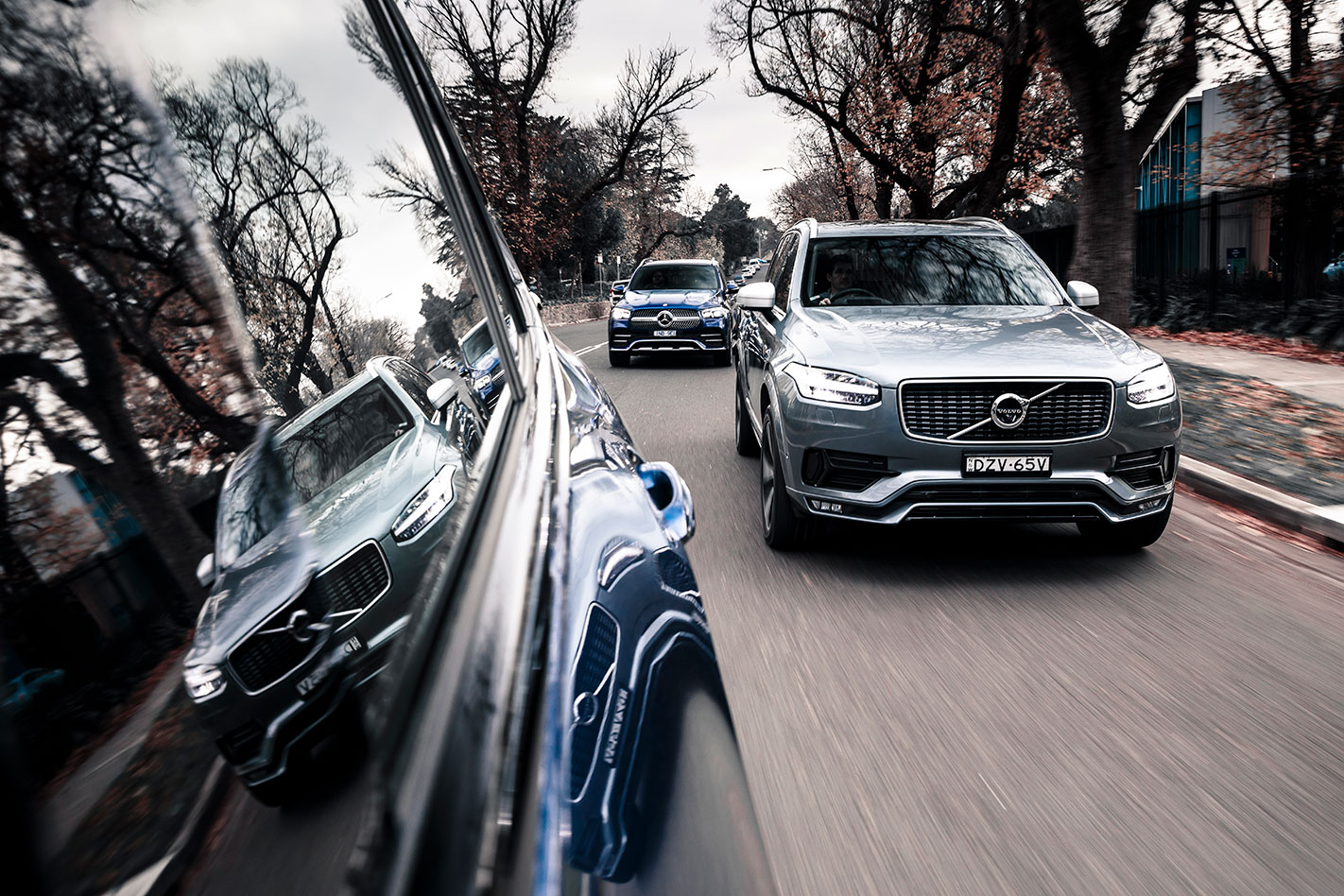
Warming to the visually appealing Merc is initially easy, but if it’s to gain market supremacy, the GLE has to beat not only the X5 but also the Volvo XC90. The big Swede is a Wheels favourite, so much so that it almost nabbed a podium place at COTY 2016 – an impressive feat. Lauded for its liveability and sophistication, the Volvo is still a high watermark to match, let alone beat.
Much like its big-wheeled counterparts, our XC90 also comes with a caveat. The optional air suspension (fitted to the rear axle) is a must. COTY testing proved that the steel-sprung set-up, in conjunction with large alloys, does not make for a compliant ride. Hence our tester has this option included as part of a Premium Pack, which also includes a load holder, Bowers & Wilkins sound system, heated rear seats and adaptive dampers – a $6500 hit to the hip pocket. Other added kit includes metallic paint ($1900), panoramic sunroof ($3000) and tinted rear glass ($950) for a grand total of $114,250 – the cheapest on test, as the GLE’s optioned price runs to $115,800.
Parked line astern, the GLE, XC90 and X5 cut a sizeable silhouette among Chapel Street’s latte-sipping brunch crew. Yet, even with the physical space each consumes in myriad shop windows, most people take no notice of their designer looks. Then, as if out of focus, two tradies approach with increasing clarity. Blurry hi-viz workware materialises into a vibrant orange hue atop faded blue short shorts – a bold choice in this climate.
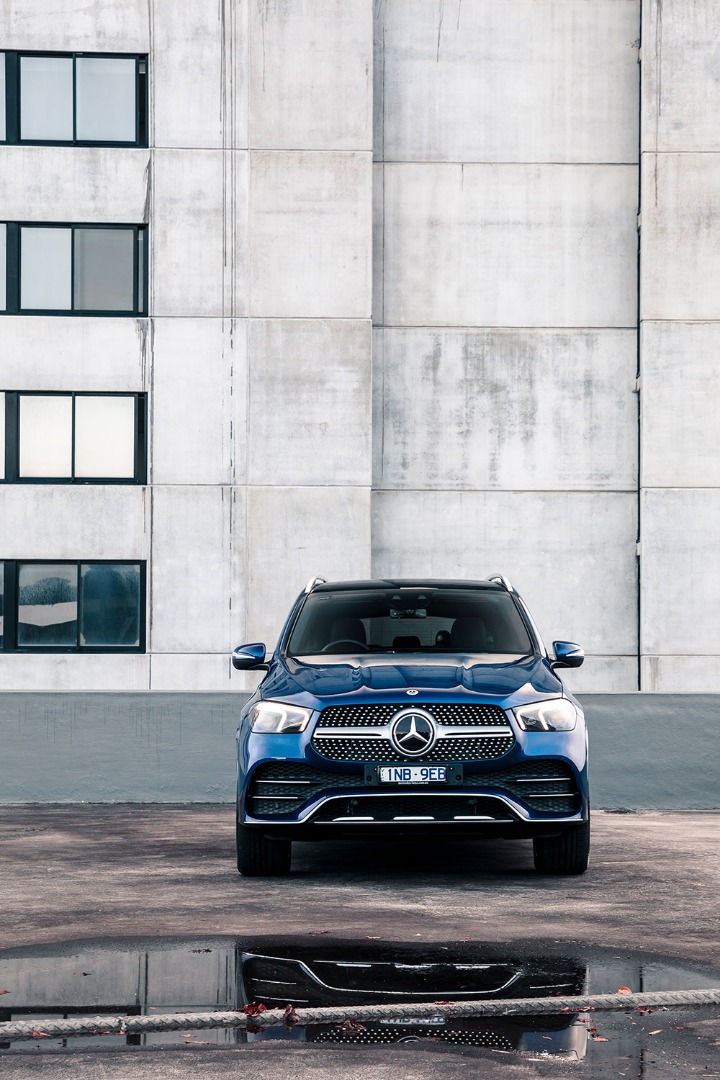
As they pass I hear a faint, “Is that the new GLE?” Admittedly the AMG styling pack fools many into thinking it’s the full-fat GLE63, but the fact two young, male tradies have pointed out an unreleased diesel SUV speaks volumes. In fact, all three SUVs are dressed in performance-oriented threads. Handsome is an adjective that falls easy to the Merc and Volvo, while the BMW, and its gargantuan kidney grille, proves a little more challenging.
We ask the tradies – still captivated by the GLE – if they want to sit inside, an opportunity grasped without hesitation. Keen to show off the capabilities of MBUX, we ask the tradies to say “Hey Mercedes”, to which the car responds, “How can I help?” Already clued-up with a line, they prompt MBUX with “open the sunroof”. A few attempts and pregnant pauses later, MBUX responds with, “I’m opening the roller sunblind”. The tradies alight the glitzy cabin suitably impressed. It would seem that the newest SUV on the family block has more appeal than simply being a kiddie-carrier consigned to a life of soccer-field car parks.
In terms of first impressions, the 300d does deliver the wow factor. In the dim melancholy of an overcast morning, the soft mood lighting warms the cabin while the seat heaters prime the soft leather of the front pews. There are layers of detail, too, with six striking air vents and genuine tactility to the climate controls – which also alter the colour of the lighting depending on temperature selection. Taking cues from the A-Class, the GLE’s twin 12.3-inch displays highlight the tech tour de force. All the button and dials are pleasing to use and convey a level of solidity, though there are a few scratchy plastics, especially the centre of the steering wheel. The latter is a shame, because the wheel itself is a special and intuitive thing to use.
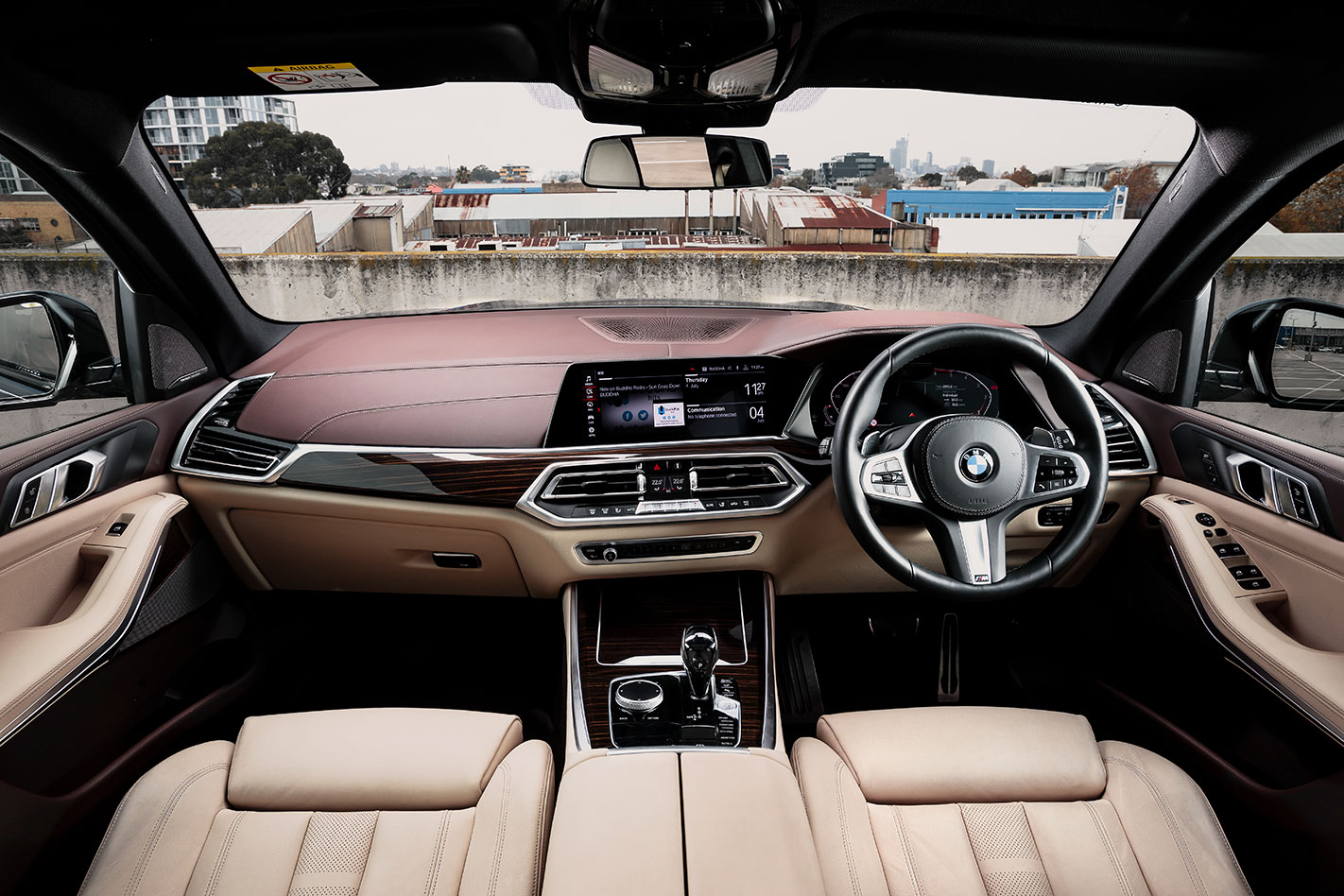
A revelation is an understatement when referencing the fourth-gen X5’s interior. BMW has finally given in to touchscreens, allowing you to dive into the high-res central 12.3-inch display as you access the brilliant iDrive 6 infotainment. The once-maligned control wheel is now virtually idiot-proof, proving easier to perfect for some over Benz’s new trackpad (although the latter is by far the best of its kind). Overall, the X5’s cabin feels the most premium, brimmingwith luxe appeal. Our test car benefited from soft pale leather, making the cabin feel light and airy, but the seats were already showing signs of discolouration from myriad bums in blue jeans.
While the GLE and X5 are fresh inside, the XC90 continues with its minimalist Scandi-chic ambience. Despite being four years old, the design remains contemporary, with the vertical, tablet-style
12.3-inch central display dominating the clutter-free dash. Ergonomically the touchscreen is excellent, and you can configure it like a smartphone, placing your icons in order of relevance. The only gripe concerns the climate controls, as changing the temperature is a two-touch affair and takes your eyes off the road. Still, the level of fit and finish, matched with body-hugging R-Design seats, means it’s a cabin standing the test of time.
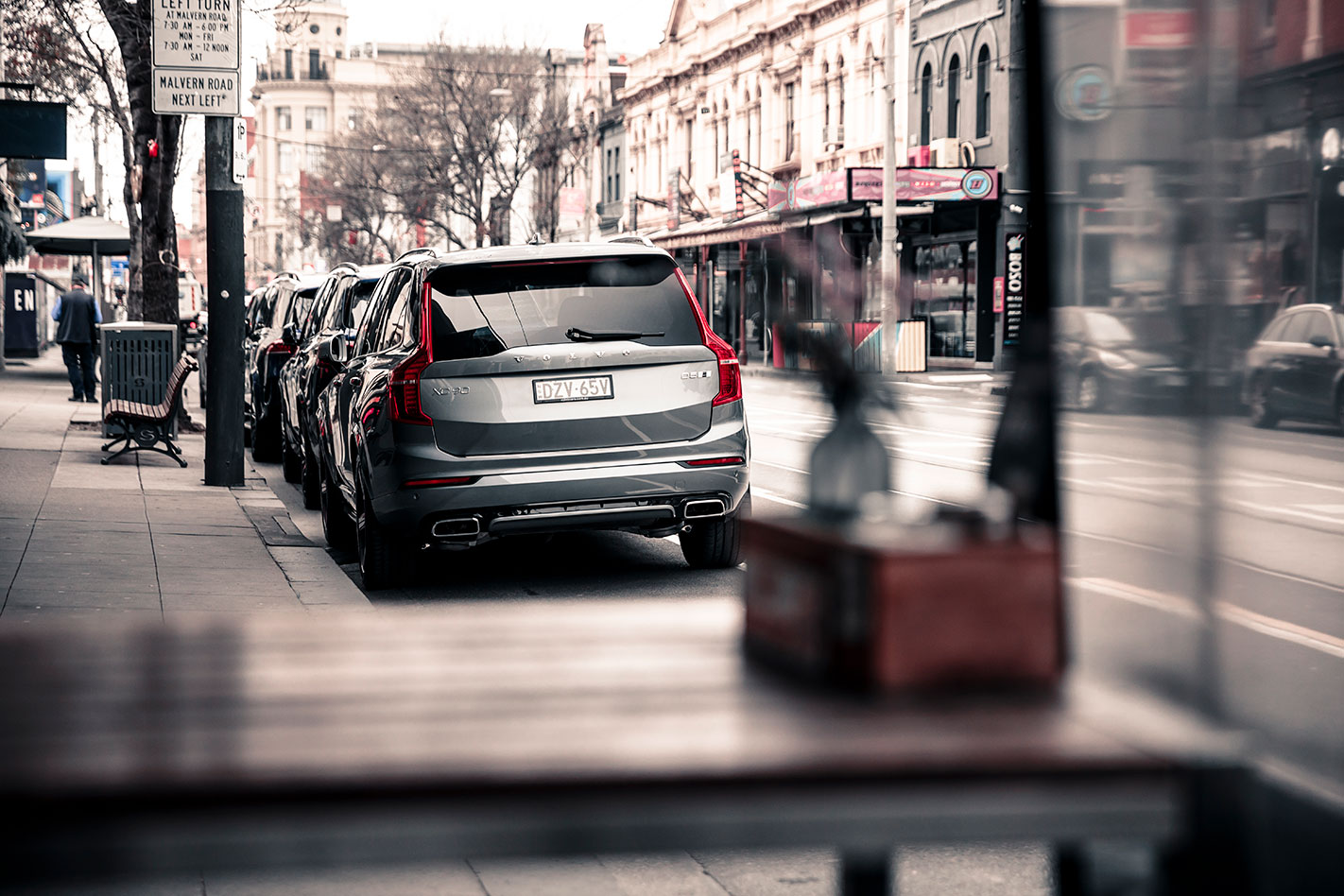
Thanks to an 80mm extension in wheelbase over the previous model, the GLE provides the most rear legroom of the bunch. In fact, despite an exterior that looks sleeker and smaller (the Merc boasts the lowest drag coefficient of any SUV at 0.29cd), the 300d is super spacious inside. Third-row seats are available for $3900, but accessing them is a tighter fit than the Volvo, which comes with three rows as standard. The Merc’s rear doors open wide, aiding the positioning of a child seat in the ISOFIX ports, while back-seat passengers gain their own controls for the climate and electric-seat operation. Boot space is the smallest here at 630 litres and the cabin’s a USB-C-only affair – there’s just one USB adapter.
Unique to the X5 is an electronically operated split tailgate to access its middle-of-the road 645-litre boot. Like the others, it has a flat floor and useful loading area. Rear-seat legroom is least opulent in the BMW, but it’s hardly squishy back there and, thanks to an airier glasshouse, the view out is better than the Merc. The rear climate controls and electric operation of the seats makes life easier and there’s a plethora of USB and USB-C ports. Seven-seater capacity is available for $3700.
While all three contenders prove practical, the XC90 takes it to another level. Predictably, the SUV from the land of flat-pack furniture has the biggest cargo capacity at 692 litres in five-seat mode. Getting into the third row is the easiest and when seated there’s decent headroom. Middle-row leg and headroom is spacious, with a higher seating position offering the best view out. However, the XC90’s cabin affords the least shoulder room, even though it’s the widest at 2008mm.
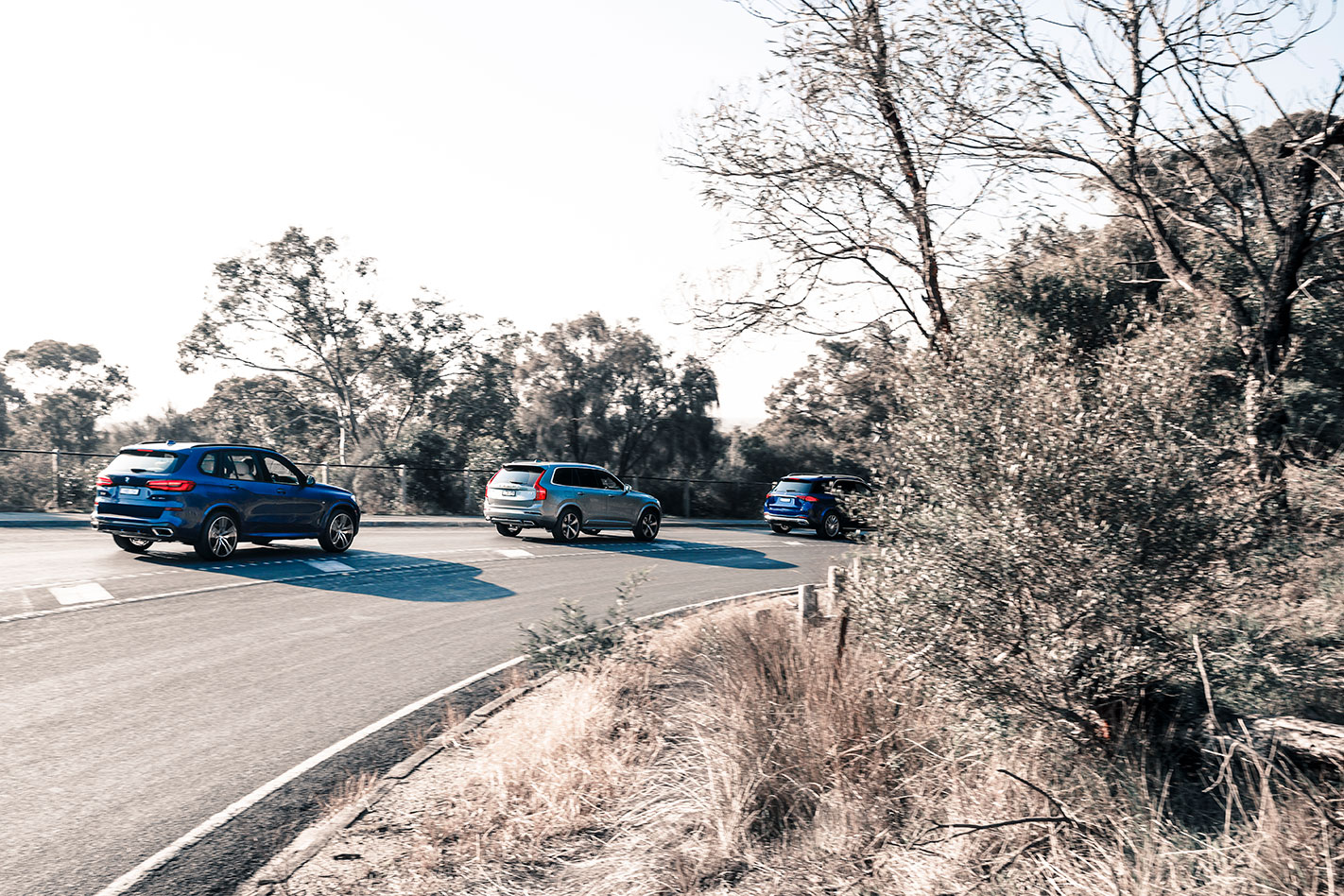
Leaving the confines of Melbourne, the drive loop encompasses a visit to the drag strip and various country roads. Off the mark is where the GLE feels its most brisk, with the 180kW 2.0-litre four-cylinder diesel producing its substantial 500Nm before 2400rpm. Although the twin-turbo OM654 utilises two-stage turbocharging, power tails off significantly around 4000rpm. This is backed up by the figures, with the Benz reaching 100km/h in 7.8 seconds, (0.4sec faster than the Volvo), but it records the slowest terminal speed down the quarter mile at 140.7km/h, 3.3km/h off the Volvo and 6.7km/h off the BMW.
In terms of refinement and performance, the X5 is peerless in this comparison. The twin-scroll, single-turbo straight-six diesel is a gem, producing 195kW and a stonking 620Nm. It nails 100km/h in 6.6sec and there’s a rich supply of torque seemingly wherever you need it. The 3.0-litre B57 makes the 30d feel under-stressed, especially when combined with the best gearbox of the bunch (ZF eight-speed) and the least diesel-esque acoustics. The only downside to the extra cubic capacity and grunt is fuel economy. During our testing, the Bavarian is thirstiest at 11.2L/100km. The GLE follows next with 10L/100km, while the XC90 proves the most frugal at 9.8L/100km.
Although, the Volvo’s engine isn’t consigned to just being efficient. The Polestar badge on its rump means that the Swedish tuning arm has fettled with the ECU, resulting in the D5 R-Design’s 2.0-litre oiler gaining an increase in power and torque to 177kW and 500Nm. While being the least nippy off the line (0-100km/h in 8.2sec), the PowerPulse system helps to eliminate turbo lag as an electric compressor forces air into the exhaust flow. You get a sense that the D5 is almost as strong as the BMW when overtaking (it’s the ‘light’ one at 1970kg, compared to the BMW at 2110kg and the GLE at 2165kg), meaning it scores highly in terms of open-road driving.
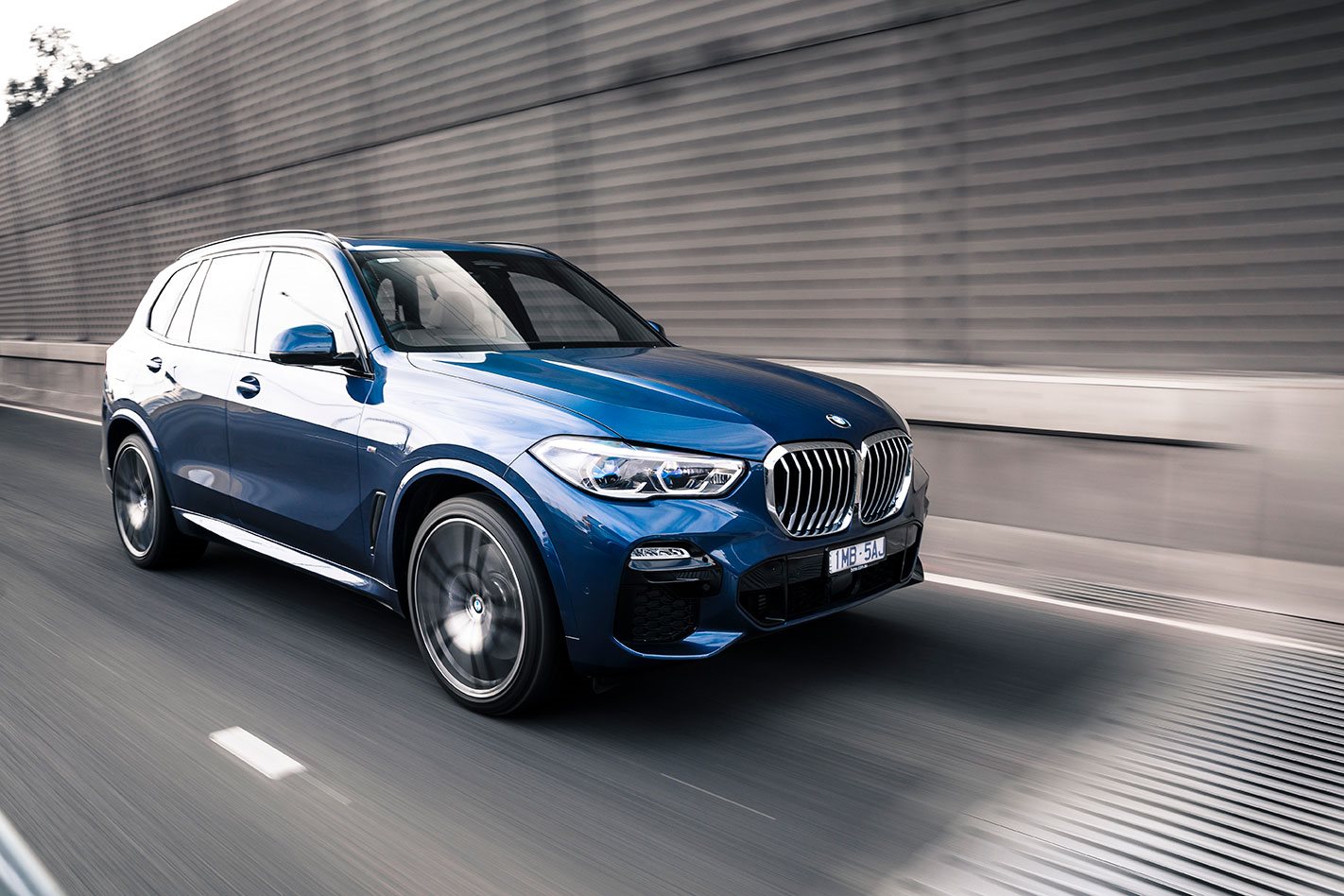
Which is where the GLE starts to fall down on its passive, steel-sprung set-up. It’s a shame, because the underlying dynamic ability of the Modular High Architecture (MHA) is left underutilised. Lightweight fibre-reinforced plastics have resulted in a 62kg weight cut over the old GLE, and the permanent 4Matic all-wheel drive offers plenty of traction with a constant 50:50 torque split. However, as the state of the tarmac deteriorates, so does the 300d’s capacity to adequately smooth the road underneath. There’s not enough finesse or suppleness to deal with sharp imperfections, with big hits felt inside the cabin. A lack of damper control on rebound means you tend to feel the vertical movements from a deep undulation long after you’ve cleared it.
The X5 also falls foul to poor optioning with its 22-inch alloys and low-profile Pirelli P Zeros providing little cushioning despite the adaptive dampers offering a Comfort mode. Yes, there’s more control than the GLE, but the adaptive two-axle air suspension, at $2300, is a worthwhile investment. With the rear-biased all-wheel-drive system sending grunt to the 315-section rear tyres, grip isn’t an issue. In terms of road holding and ‘fun’ factor, the X5 is the standout.
The D5 R-Design might not be as engaging dynamically, but the Volvo is certainly the most comfortable. With the air suspension adding a suppleness and compliance sorely lacking in the Merc (and to a lesser degree in the BMW), the D5 is the most comfortable. It deals with bumps with aplomb, the only blight being a slight increase in bodyroll and lean due to its tall body. Suppression of tyre roar and general NVH is the best here, too.
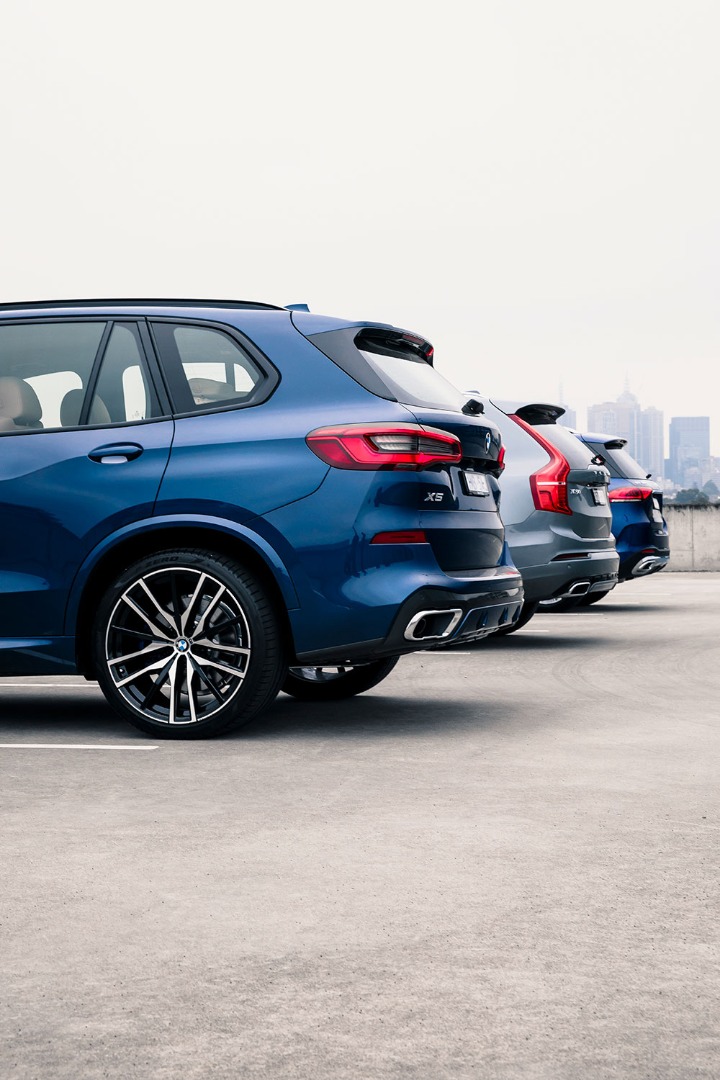
Ultimately, when it comes to the final assessment, there’s no question the GLE is a vast leap forward for Mercedes. The interior is comfortable, roomy for a family and bursting with equipment that’s headlined by MBUX. It’s luxurious and quiet with strong fuel economy and off-the-line performance. However, it feels as though we aren’t testing it in its strongest guise. The 300d simply can’t match the oomph of the more expensive BMW and it lacks the serene nature of the brilliantly executed Volvo.
What lets the Benz down in this company is ride quality. Had our tester been fitted with optional suspension like its rivals, the end result would be closer and the fight a little fairer. Take heed, then – air suspension is a must when speccing your GLE. And if you can, stretch to the gutsier six-pot petrol or diesel engines. As it is, however, our GLE finishes third. It’s a desirable proposition, but in this particular company, it’s outperformed.
The BMW finishes with the same eight-out-of-10 rating as the GLE, though its superb drivetrain, sharper dynamics and quieter cabin see it edge second place. What prevents the X5 from snaring the top spot is its heftier thirst, questionable ride quality and a significant price premium. Even at this affluent end of the $100K-plus market, monetary pain can’t be ignored.
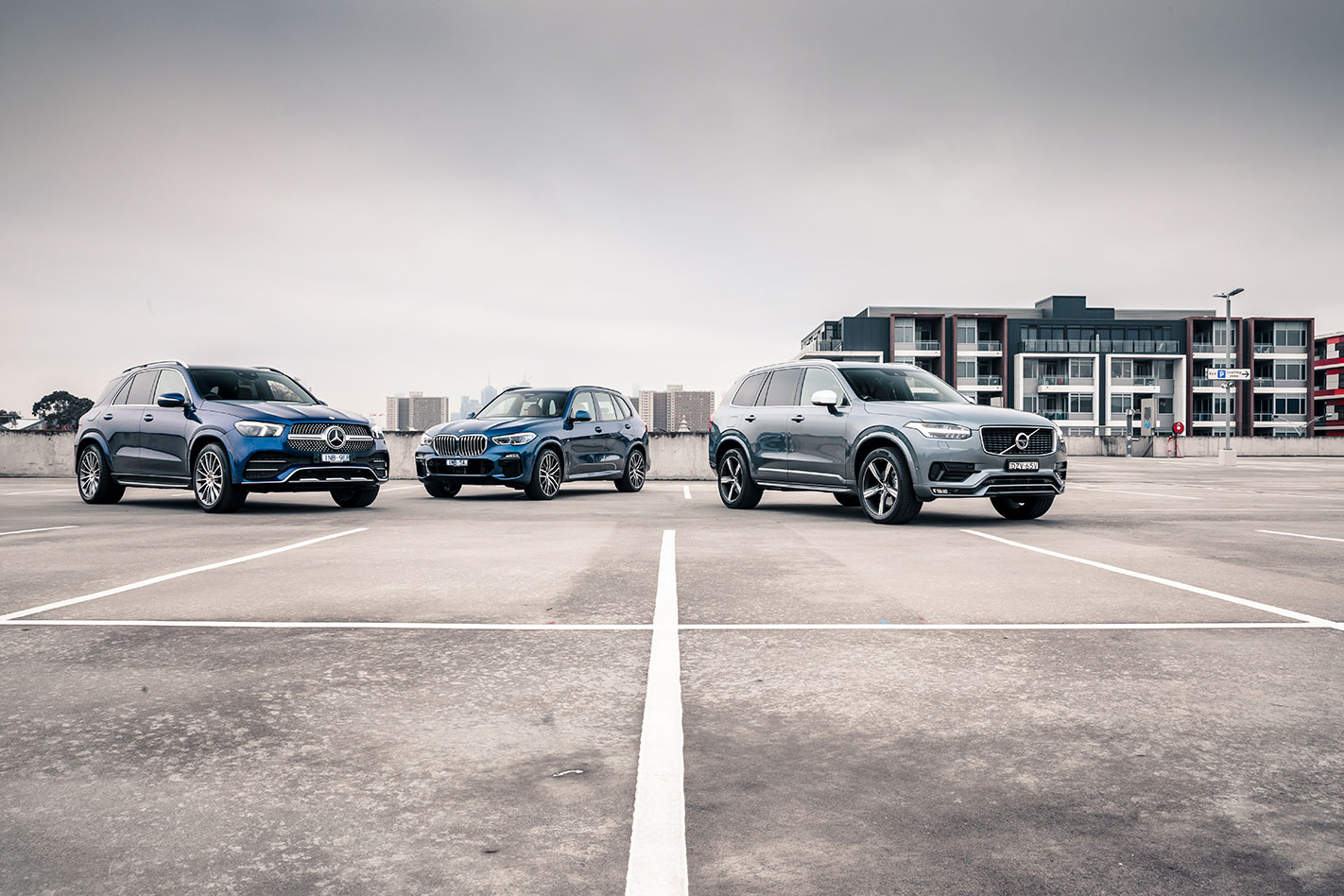
That leaves the XC90 as the somewhat unexpected winner despite being the oldest contender. It’s by no means perfect and the Volvo can’t match the sheer technological might you get in the cabins of the Merc and BMW. Yet, it represents the best value, it gains seven seats as standard and continues to set the class yardstick for refinement and overall quality.
As an indulgent family SUV that fulfils its brief, the suave Swede might not be streets ahead, but it’s the one you’ll want to buy. No receipt required.
Where’s the VW Touareg?
We asked for one, but a VW Touareg in Launch Edition guise wasn’t made available to Wheels for this SUV comparison. At $89,990 for the range-topping variant, the fully loaded flagship offers a powerful 190kW/600Nm V6 turbo-diesel with a claimed consumption of 7.4L/100km. Dominating the spacious interior is the 15-inch infotainment screen, however, it’s part of an $8K option pack. Still, it would have been interesting to see how the Vee-Dub fared against truly premium rivals.


